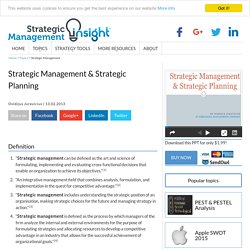

Looking at Holacracy? Don’t Be So Quick to Eliminate Your Management Structure. Take, for example, Zappos.
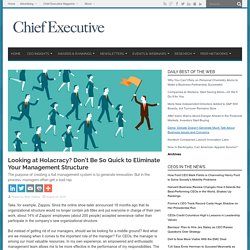
Since the online shoe-tailer announced 18 months ago that its organizational structure would no longer contain job titles and put everyone in charge of their own work, about 14% of Zappos’ employees (about 200 people) accepted severance rather than participate in the company’s new organizational structure. But instead of getting rid of our managers, should we be looking for a middle ground? And what are we missing when it comes to the important role of the manager? For CEOs, the manager is among our most valuable resources. In my own experience, an empowered and enthusiastic management team allows me to be more effective in the performance of my responsibilities. “While we must attack wasteful structures, processes and positions, the role of the manager should not be eliminated. Unfortunately, and unfairly, the manager takes the blame for the shortcomings in the way many companies are structured.
Managers are NOT the problem. Read more on this subject: Make it, Don’t Buy it: Why You Need to Maintain Your Company’s Innovation Mojo. What’s changed is that many big technology firms no longer even try to invent the Next Big Thing.
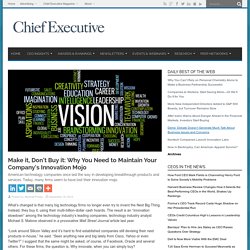
Instead, they buy it, using their multi-billion-dollar cash hoards. The result is an “innovation slowdown” among the technology industry’s leading companies, technology industry analyst Michael S. Malone observed in a provocative Wall Street Journal article last year. “Look around Silicon Valley and it’s hard to find established companies still devising their next products in-house,” he said.
“Seen anything new and big lately from Cisco, Yahoo or even Twitter?” This slowdown in product innovation is mirrored by a similar decline in basic science research. “Corporations, constantly pressured to increase the next quarter’s profits in the face of powerful foreign competition, are walking away from basic science too, [and] big companies now [can] more easily buy innovative startups.” But either way, the bottom line is unavoidable.
Growing Talent to Turbocharge Strategy: What CEOs Can Do. The following bullet points summarize the discussion held on this topic during this CEO Solution Exchange at the 2015 CEO Talent Summit in Dallas, TX, Sept. 30-Oct. 1, 2015: CEOs should be systematic about their own development to lead a learning organization where people own their functional areas and expertise to drive innovation and growth.CEOs need to learn to relax.
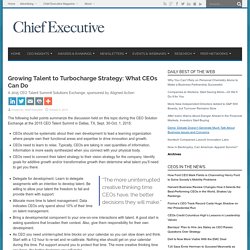
Typically, CEOs are taking in vast quantities of information. Information is more easily synthesized when you connect with your physical body.CEOs need to connect their talent strategy to their vision strategy for the company. Identify goals for additive growth and/or transformative growth then determine what talent you’ll need to get you there. “The more uninterrupted creative thinking time CEOs have, the better decisions they will make.” Delegate for development. How to Increase Your Organization’s Collaborative Intelligence. Around the world, almost universally, organizations have set themselves up in such a way that they are not only silo’d, but structured so that individuals, departments and even complete lines of business that have KPIs set up in opposition with each other.
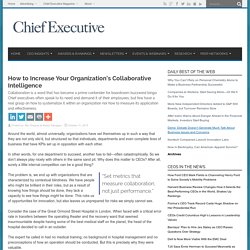
In other words, for one department to succeed, another has to fail—often catastrophically. So we don’t always play nicely with others in the same sand pit. Why does this matter to CEOs? After all, surely a little internal competition can be a good thing? “Set metrics that measure collaboration, not just performance.” The problem is, we end up with organizations that are characterized by contextual blindness.
Consider the case of the Great Ormond Street Hospital in London. The expert he called in had no medical training, no background in hospital management and no preconceptions of how an operation should be conducted. Breaking with tradition and precedent, they engaged the Pitt Crew Boss for Ferrari’s Formula 1 racing team. 1. 2. 3. 4. 3 Leadership Tips to Create an Inspiring and Innovative Company Culture. According to the PwC’s Global CEO Pulse Survey on Innovation, 57% of CEO respondents said that having the right culture to foster and support innovation is the most important ingredient for successful innovation at a company.

Truly innovative CEOs recognize that innovation doesn’t only happen in their research and development (R&D) departments but throughout the whole company. The key to creating the right culture for innovation is to have a holistic and humanistic approach in leading your employees and having this approach trickle down from your executive team to the rest of the organization. “Avoiding tough situations that need to be addressed and sweeping them under the rug is sure to backfire.” Applying the following leadership strategies can cultivate a positive and supportive organizational culture, making it possible to foster innovation. 1. 2. 3.
Strategic management. Strategic management involves the formulation and implementation of the major goals and initiatives taken by a company's top management on behalf of owners, based on consideration of resources and an assessment of the internal and external environments in which the organization competes.[1] Strategic management provides overall direction to the enterprise and involves specifying the organization's objectives, developing policies and plans designed to achieve these objectives, and then allocating resources to implement the plans.
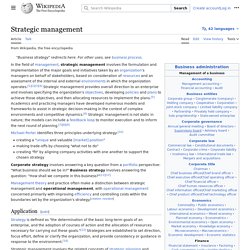
Academics and practicing managers have developed numerous models and frameworks to assist in strategic decision making in the context of complex environments and competitive dynamics.[2] Strategic management is not static in nature; the models often include a feedback loop to monitor execution and inform the next round of planning.[3][4][5] Corporate strategy involves answering a key question from a portfolio perspective: "What business should we be in? " J. Strategic Management & Strategic Planning. Definition.
